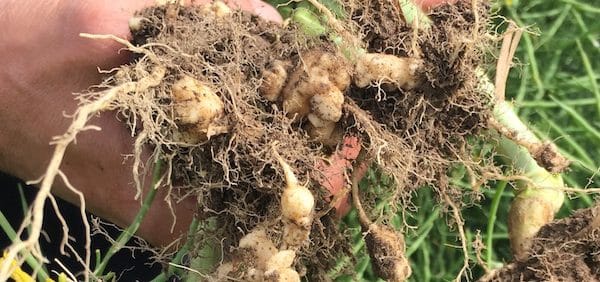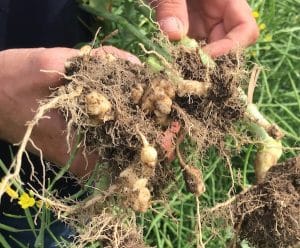In Saskatchewan, visible clubroot symptoms have been found in two fields in the northwest part of the province in RMs where clubroot symptoms were not previously confirmed. This serves as a reminder to all canola growers to scout fields – both clubroot resistant (CR) and susceptible varieties – closely for visible clubroot symptoms and remain diligent in preventing and managing clubroot.
Random scouting of healthy looking plants is important because by the time galls are big enough to cause above-ground symptoms, clubroot has taken a firm hold in the field.
Variety choices for next year. With the goal to keep spores ‘low and local’, early deployment of clubroot-resistant (CR) canola is important when clubroot is confirmed in an area and certainly when any trace of clubroot spores are found on the farm.
The CR trait will prevent most infection, which will help to keep spore counts low in fields that already have lower counts. With fewer resting spores in the soil, the risk of building up virulent pathotypes is reduced.
Use the following checklist to decide whether a CR variety is right for your farm. If any one statement is “false”, a CR variety may be the best choice.
- I vigorously checked all of my fields (not just those in canola this year) to confirm that clubroot is not found on my farm. (True or False)
- I sent in soil samples from fields that will be in canola next year and they tested negative for the pathogen. (True or False)
- My neighbours have checked their fields and they don’t have clubroot. (True or False)
- I have not heard of any clubroot in my community. (True or False)
- No outside equipment/traffic has entered my fields since I last scouted them for clubroot. (True or False)
When spore counts are allowed to reach high levels: clubroot is more easily moved from field to field, clubroot will cause yield loss in susceptible canola (even with a four-year rotation) and clubroot will overcome CR traits.
Note that growing CR varieties alone is not enough to stop spore build up. Crop rotation and weed control are also required.
Crop rotation. Evidence from three rotation studies done in Canada (two at Normandin, Quebec, one in Alberta) suggests that two years between host crops is the minimum rotation to manage clubroot spores in a field.
Weed control. Volunteer canola, flixweed, shepherd’s purse, stinkweed and mustard will all host clubroot and leaving these weeds uncontrolled in rotation crop will greatly reduce the benefit of crop rotation to manage clubroot.


